By Robert Bruce
“The PLA (People’s Liberation Army of Communist China) is also exploring satellite jammers, kinetic energy weapons, high-powered lasers, high-powered microwave weapons, particle beam weapons, and electromagnetic pulse weapons for counterspace application.” US Department of Defense, Annual Report to Congress: Military Power of the People’s Republic of China, 2008. The Chinese have already demonstrated their mastery of directed energy weapons (DEW) as a strategic spacewar capability by killing spy satellites in orbit. The PLA, aided by cynically mercenary experts from a catalog of nations including some US “allies,” is accelerating its program to develop and field ever more powerful and versatile DEW that are suitable for both strategic and tactical employment.
Same for the Russians – said by the Defense Intelligence Agency to have used vehicle mounted lethal power lasers in their Afghanistan debacle – who have been vigorously pushing the frontiers of science for decades in building efficient particle beam, laser and microwave weapons.
Serious discussion and planning throughout the US Department of Defense points to an official certainty that a range of advanced weapons beyond traditional kinetic energy types (hard projectile pushers) will be used by all combatant forces on the battlefields of the near future.
“Death Rays” Revealed
A useful introduction to the three major classes of DEW is provided here, courtesy of the Chinese themselves, who are clearly watching what’s being done in the West to parallel their own efforts.
“Directed energy weapons are new-generation weapons developed on the basis of the new concept of replacing conventional bullets with high-energy beams. Technically, directed energy weapons can be divided into three branches, namely (1) laser weapons, which can destroy or destabilize targets by using electromagnetic radiation energy beams with a wavelength of less than 1 millimeter; (2) radio-frequency weapons, which can destroy or destabilize targets with electromagnetic energy within the radio spectrum range (wavelength is more than 1 millimeter and radio frequency less than 300 gigahertz); (3) particle beam weapons, which are capable of destroying or destabilizing targets with neutral high-energy atomic particle beams (usually hydrogen, deuterium and tritium) or charged high-energy atomic or subatomic particle beams.” Zhang Yaping, Peoples Republic of China Astronautics and Missilery
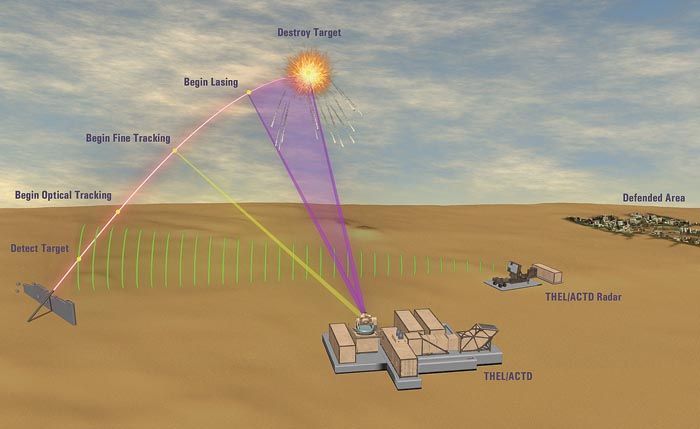
As laser and microwave systems are most prominent among presently workable DEWs, it is essential to understand that both types are electromagnetic radiation but are different in their wavelength.
We’ll dispense with the scientific explanations and just say that many types of laser emissions are visible to the human eye but microwaves are not. Lasers begin burning the outside of an object while microwaves “cook” from the inside. More detailed information may be found in the resources listed at the end of this feature.
DEW Proliferation
China and Russia are not alone among America’s likely adversaries with current or emerging DEW capabilities. Numerous US government, military and industry documents that are readily available to anyone on the internet confirm the obvious.
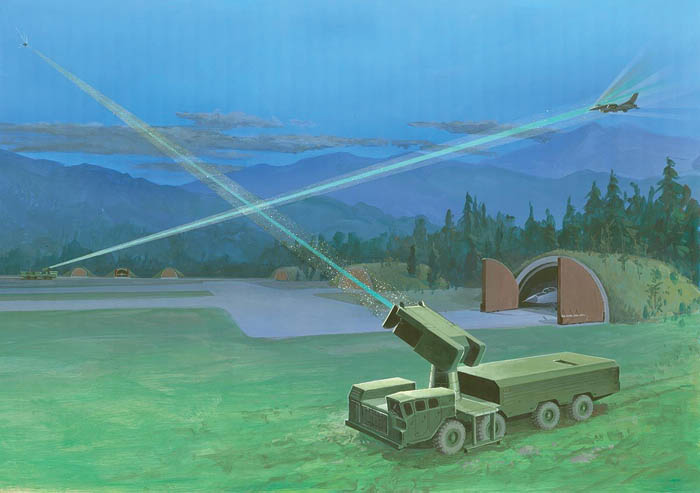
A case in point is the December 2007 report to the US Secretary of Defense by the Defense Science Board Task Force on Directed Energy Weapons. Even after being carefully scrubbed of classified information, its chapter on current and emerging threats reveals a chilling likelihood. Addressing vulnerabilities recognized in sophisticated electronic command and control systems – extending from orbiting satellites to tactical team individual radios – the task force zeroes in on the threat posed by laser systems and high power microwave technologies: “They are particularly susceptible to the types of directed energy systems that are believed to be feasible for a wide range of potential adversaries … including non-state actors.” (Emphasis added)
Translated from typically overcautious bureaucratese, this means that all levels of the US-Allied “digital battlefield” can be too easily rendered blind, deaf and mute by devices available now to many countries and their terrorist surrogates (non-state actors). Just one example of this may be found in Iran, which buys high tech weapons from Russia, China and elsewhere, then funnels them to al Qaeda and other “insurgent” forces in Iraq and Afghanistan.
What is going to happen when the free world’s many enemies begin employing DEW not only against US and Allied C3I (Command, Control, Communications and Intelligence), but its soldiers as well?
Laser Sniping
We don’t need to wait until fully lethal DE weapons become widely available. Just enough power and range to blind will work just fine for those with no regard for the so-called laws of warfare and the civilized world’s condemnation.
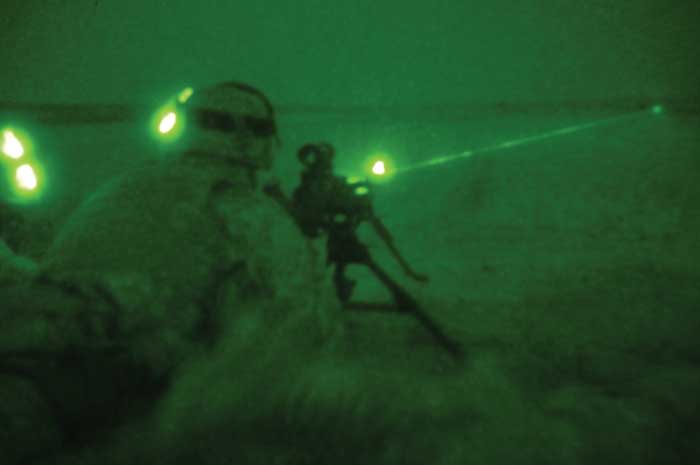
This fits quite well the long-standing military maxim that inflicting incapacitating wounds is more tactically useful than killing the enemy because evacuating and caring for a badly wounded soldier distracts more of his fighting comrades from their primary battlefield mission.
Frying eyes with surprisingly low-powered lasers is a capability that is real and right now, a sobering thought for anyone whose job includes peering through weapon scopes, binoculars, AFV periscopes, and other optical devices.
The ZM-87, China’s Portable Laser Disturber, is a tripod-mounted weapon that can be carried and used by a crew of two. Its utility as a blinding weapon has been demonstrated in documented attacks.
Similarly, a laser “range finder” aboard the Russian spy ship Kapitan Man is known to have caused retina burns on a US Navy officer aboard an allied maritime surveillance helicopter in 1997.
The Federation of American Scientists reports that, “during the Iran-Iraq War, Iranian soldiers suffered over 4,000 documented eye casualties from Iraqi laser systems….” The injuries were described as retinal burns and hemorrhages, most of which were likely caused by deliberate antipersonnel use of the laser rangefinders in Saddam Hussein’s Communist-bloc tanks.
But that’s just the beginning. Ever popped corn in a microwave? Or used a magnifying glass to start a fire? Directed energy weapons are poppers and burners on a massive scale.
Uncle Sam’s DEW Programs
We are relieved to note that the United States and a few allies are well along the way in energy beam weapons programs, some dating back to the 1970s. Countering the very real threat of the Soviet Union’s massive arsenal of thermonuclear-tipped intercontinental ballistic missiles drove both high power laser and particle beam development. These reached a degree of practicality that readily transitioned in the 1980s to the Strategic Defense Initiative, popularly known as “Star Wars.”
In the decades that have followed, the strategic and tactical capabilities of these and other DE technologies have accelerated in work by a veritable alphabet soup of government and military programs. Just a sampling of these includes DARPA (Defense Advanced Research Projects Agency), SMDC (Space and Missile Defense Command), AFRL (Air Force Research Laboratory), and ONR (Office of Naval Research). Their many partners in the defense industry and academic institutions extend the roster of DEW players to virtually every state in the union.
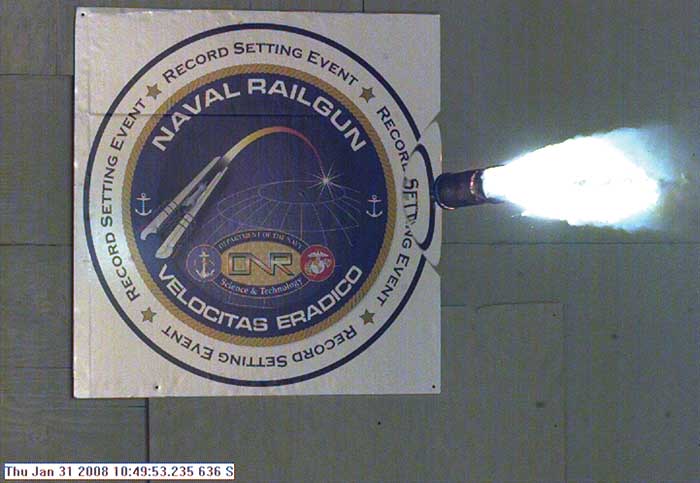
Astronomical funding levels have paid off with astonishing capabilities. DEW in various forms are tracking and killing not only massive intercontinental ballistic missiles, but also multiple mortar rounds in flight. They’re melting electronic brains in the smartest of “smart weapons.” Shipborne DE systems can zap sea-skimming missiles. Airborne lasers can instantaneously fry individual terrorists with surgical precision that eliminates the usual “collateral damage” imagery that Al Jazeera and others delight in broadcasting.
Lasers
There are several different ways that the photon beams of lasers are generated in DEW, with major categories being chemical, free electron, bundled optical fiber, and solid state. This last is the simplest, typified by the battery powered pointer-illuminators now clamped to just about every M4 carbine in Uncle Sam’s military and extending to some experimental vehicle-mounted anti-materiel systems.
Included in the grouping of relatively low powered lasers are “dazzlers,” so called for their ability to distract and disorient their human targets using carefully controlled beam intensity that won’t cause lasting eye damage.
AFRL’s ScorpWorks has built a particularly novel dazzler with a name that invokes memories of the science fiction television series Star Trek. Their PHaSR (Personnel Halting and Stimulation Response) is a rifle-sized, non-lethal device in a futuristic housing. It projects two laser wavelengths with an effect “temporarily impairing individuals and their ability to see the laser source.”
Ground vehicle mounted systems are the next step up, quickly gaining in power and tactical potential. ZEUS, SMDC’s high energy solid state laser riding on a HMMWV, has been successfully field tested as a killer of IEDs (Improvised Explosive Devices) in Afghanistan. Effectiveness of this and similar pilot program systems has spurred development of more powerful and tactically mobile High Energy Laser Technology Demonstrators. These are already showing the ability to counter a wide variety of battlefield threats including rockets, artillery shells and mortar rounds.
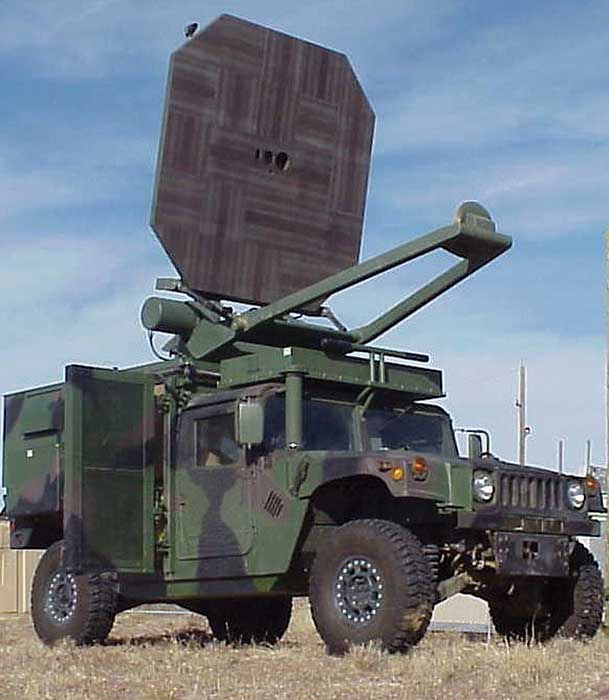
A Bolt from the Blue
There is plenty of evidence that the demand for DEW is increasing throughout the US Armed Forces, driven in particular by current operational realities in the Global War on Terror. A compelling example of this may be found in US Special Operations Command’s (USSOCOM) Technology Development Objectives, briefed at NDIA’s Special Operations/Low Intensity Conflict symposium in 2008.
Among other eyebrow-raising requirements is their intention to “pursue a greater variety of integrated, tunable weapons – non-lethal weapons with a tunable destructive potential – to accommodate a broad variety of missions while limiting collateral damage and casualties.”
Keep your eye on that part about “tunable destructive potential” because that’s the most exciting possibility for DEW of the near future. And some possibilities are already flying.
When vastly more power is needed for destructive lasing to greater range and effect, scientists have devised some supremely clever ways to create and hurl man-made “lightning bolts.” Particularly dramatic evidence of the progress of this weaponry may be found in the US Air Force’s Airborne Laser, flying now in a modified 747. Its megawatt-class Chemical Oxygen Iodine Laser (COIL) has repeatedly demonstrated the air-to-air capability of destroying ballistic missiles in flight.
This success has inspired US Special Operations Command to order an air-to-ground version, called the Advanced Tactical Laser (ATL), with an eye toward eventually replacing its fleet of aging AC-130 Spectre and Spooky gunships. Their conventional kinetic-energy weapons will be supplemented at first by a COIL, then completely replaced, enabling engagement of a variety of ground and air targets with previously unattainable precision and instantaneous effect. If the project stays on track, first operational use of the new ATL may occur before the end of 2009.
An apparently authentic Coalition Forces (CF) document, widely circulated on the internet, touts the many desirable characteristics of the ATL under its USMC name Precision Airborne Standoff Directed Energy Weapon (PASDEW). These include “application of graduated effects” (tuning the beam to less-lethal or selectively aiming the full power beam) for such important tasks as stopping vehicles by flash melting the tires.
It also predicts mind-boggling PSYOPS (psychological operations) advantages of the ATL and similar beam devices in uncharacteristically graphic terms:
“In an anti-personnel mode, DEWs can be compared to long range blow torches or precision flame throwers …. A precision engagement of a PID (positively identified) insurgent by a DEW will be a highly surgical and impressively violent event. Target effects will include instantaneous burst-combustion of insurgent clothing, a rapid death through violent trauma, and more probably a morbid combination of both. It is estimated that the aftermath of a sub-second engagement … will also be an observable event leaving an impression of terrifyingly precise CF attribution in the minds of all witnesses.”
Microwaves
While microwaves – radio waves of extremely short length – have been around since WWII, their use in weapons has only recently emerged. Unmatched in their ability to penetrate deep inside even heavily shielded electronic devices, microwaves can melt circuits and instantly turn a multimillion dollar gadget into a great big smoking box of junk.
And just as your ordinary microwave oven heats food, a tunable military HPM (high powered microwave) emitter can readily “dial-an-effect” on various targets ranging from tingling to toasting.
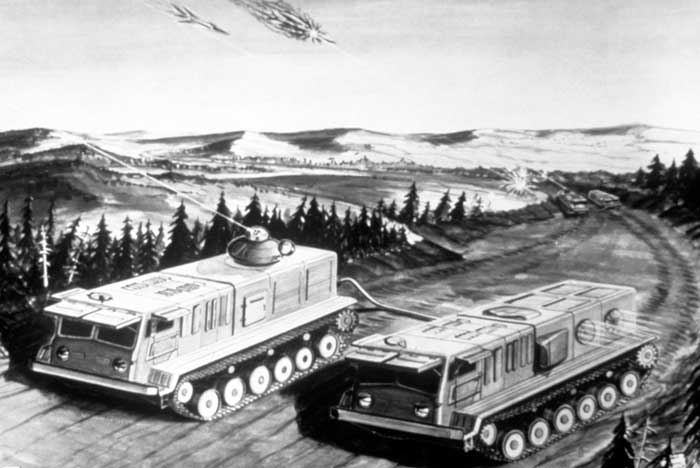
The tingling end of this range is of particular interest to DoD’s Joint Non-Lethal Weapons Directorate for applications where the objective is to disrupt and disperse hostile crowds without resorting to messy traditional means like tear gas, rubber bullets and the like.
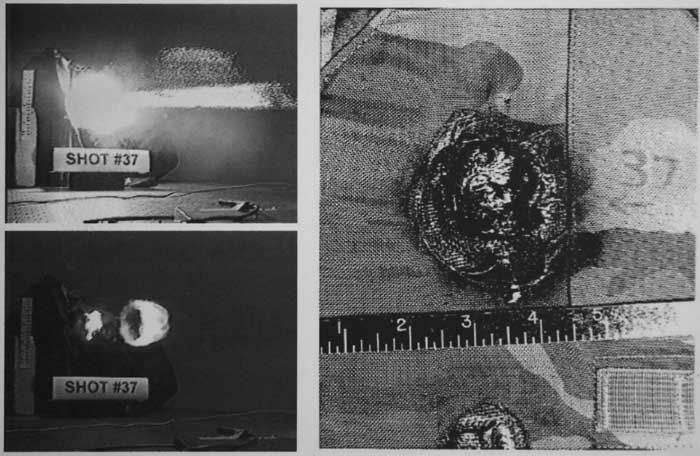
This alternative is nicely realized in Air Force Research Laboratory’s Active Denial System (ADS), a counter-personnel, non-lethal, directed energy weapon that projects a focused beam of millimeter waves toward a designated individual or group. An invisible beam, traveling at the speed of light, penetrates clothing and reaches a skin depth of about 1/64th of an inch, the equivalent of three sheets of ordinary copy paper. Test subjects report that an intense heat sensation results, growing intolerable within seconds and forcing the targets to instinctively flee.
Although another desirable attribute is not usually listed in ADS program promotional materials, the invisible internal effects of the invisible microwave beam actively deny hostile media the inflammatory video imagery that is their stock in trade. And don’t forget its tunable/scalable capability that just might tempt the on-site commander to fry the electronic circuitry of all video equipment anywhere in range.
The first mobile configuration ADS is characterized by a large octagonal antenna mounted on a sturdy HMMWV that carries its power and microwave generating apparatus. Development has matured to the point of deployment with USAF Security Forces and prime contractor Raytheon has recently delivered ADS II, a more powerful, enhanced and ruggedized version mounted on the massive HEMETT vehicle.
DE at JSSAP?
The Joint Service Small Arms Program (JSSAP), part of the Army’s enormous Armaments Research, Development and Engineering Center (ARDEC), identifies and develops cutting edge concepts in weapons and ammunition to the point of transition leading to large scale fielding. In other words, these are the “go to guys” to find out what’s currently on conveyor belts that run ten years or more into the future.
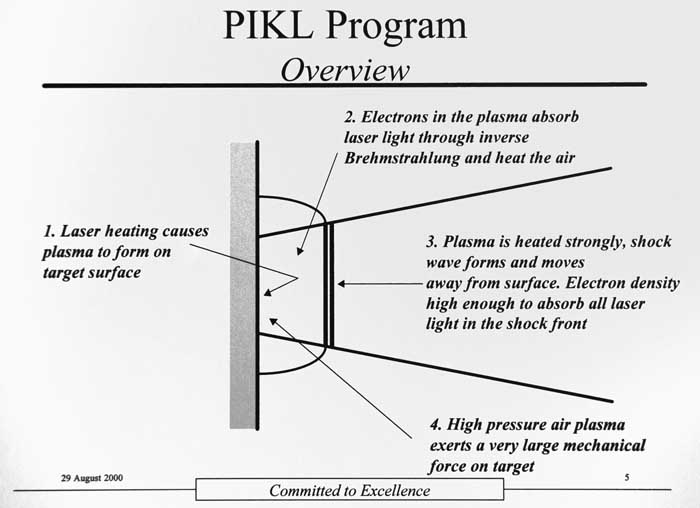
JSSAP recently published a solicitation that welcomes “non-traditional technology” for next generation small arms systems. The following excerpt shows that serious proposals from the DE community are apparently welcome:
REQUEST FOR PROPOSALS SUPPORTING FUNDED R&D EFFORTS FOR LETHALITY AND ADVANCED FIRE CONTROL TECHNOLOGY CONCENTRATIONS FY 2008 – 2010 W15QKN-08-R-0449
2.7.9. New Concepts & Applications. This research area includes non traditional technology leading to leaps in capability, such as (1) non kinetic energy lethality mechanisms or energy systems that can be scaled from lethal to less than lethal; (2) warheads or projectiles that can offer lethal and less than lethal capability; and (3) systems that automate the target acquisition and take weapon aiming out of the hands of the soldier. Unique and untried approaches to defeating targets in defilade also fit within this technology/research area.
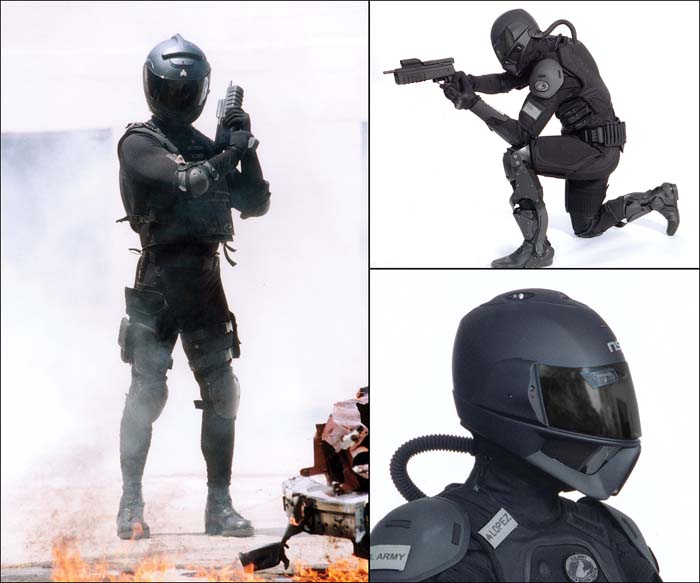
Joel Goldman heads up JSSAP, so we asked him to let us know what’s going on there with DEW. He pointed us in two directions, first to a fascinating working group that JSSAP had recently convened and then to another component of ARDEC that is specifically involved in such things.
Before moving on we spoke at some length with Goldman, who told us he’s been closely following developments in directed energy for quite some time. And his well-informed opinion on the central question of this feature: When will the first fully scalable, hand-held DEW be fielded?
“Based on the periodic technology assessments that JSSAP has conducted,” the 63 year old, government gun guru with 38 years service declared, “not in my lifetime.”
The Fusion of Science and Science Fiction
In part of its search for far-reaching concepts that are worthy of serious consideration, JSSAP has periodically convened meetings to survey the state of the art of a broad range of technologies that might have relevance to small arms. Beginning in the mid-1980s, JSSAP has consistently involved science fiction writers in these brainstorming and assessment activities. The latest instance of this decidedly unconventional approach occurred as the first of a two-part activity held in March and early May 2008 in support of “Future Small Arms Technology Plan Development” efforts. In the first meeting, JSSAP brought together a select group of nine prominent science fiction writers to brainstorm the frontier of scientific possibilities. Their mission was to propose “leap-ahead technologies” and – with the help of select representatives from industry, academia, the national laboratories, and government – to assess their possible practical potential. 74 concepts resulted, sorted into five categories; intelligence gathering, human factors, survivability, battlefield impact, and firepower.
Their ideas, one of which called for tapping energy from the quantum vacuum, were then given a hard, cold look by a team of science, engineering and military experts during the second meeting. While at this writing the report is still in preparation and its specifics not available for release, Goldman told us that at least twenty concepts have emerged.
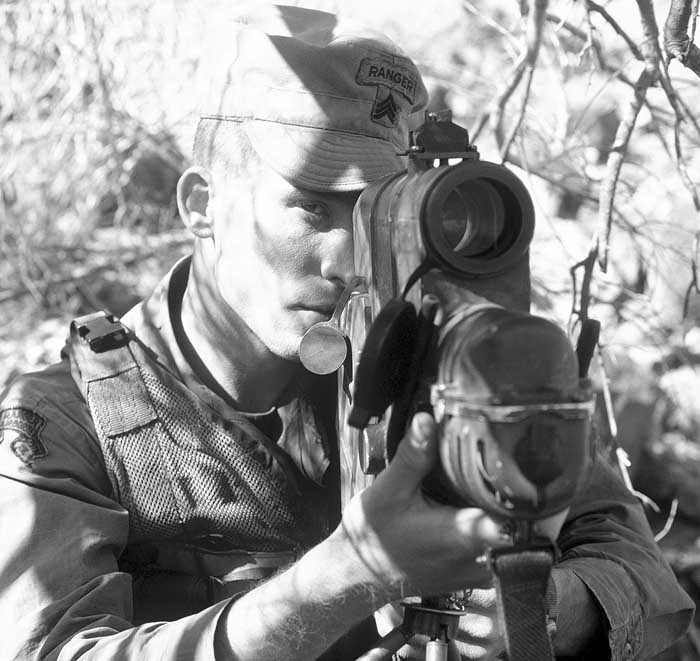
“These are viable, relevant and will find a place,” Goldman explained, “in a technology investment strategy for small arms systems capable of overwhelmingly defeating any enemy combatant of the future.”
As SAR is most interested in firepower, we tracked down a couple of participants who, in our opinion, bring particular credibility based on their professional work outside of sci-fi.
John Hemry, a retired US Navy lieutenant commander, is the author of the notable STARK’S WAR series and, under the pen name Jack Campbell, the LOST FLEET series. Speaking of his working group, he reports that “no one thought there would be huge or dramatic breakthroughs in small arms in the near future.”
Instead, Hemry’s own suggestions to JSSAP centered on target recognition and engagement. “The best way to enhance weapon effectiveness in the near future,” he believes, “is to improve the ability of the shooter to identify and target the enemy.”
Doctor Arlan Andrews, Sr., another member of the group, suggests a different track. Notable not only for service in the White House Science Office, Sandia National laboratories and more, Andrews founded an eclectic group of sci-fi writers comprising the SIGMA group. Now well into its second decade of advising government agencies and the military on what the future may hold, SIGMA is most recently known for work with the Department of Homeland Security on innovative ways to combat terrorism.
Andrews enthusiastically responded to SAR’s request for input on his suggestions to JSSAP, sending us a copy of his elaborate PowerPoint presentation to the working group. Entitled “Nanotech-Enabled Weaponry and Features,” it is worthy of a full article in itself. Alas, since it concerns devilishly smart kinetic energy weapons and variable power ammo – but no beam devices in sight – we’ll defer elaboration and go right for the reply he sent us in response to the title question of this article.
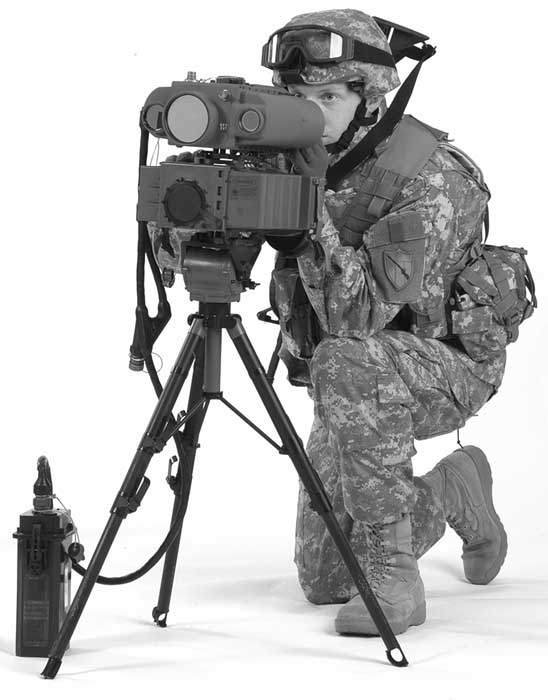
The good Doctor Andrews, refreshingly unconcerned it seems with diplomatic sensitivities and likely influenced by conversations with personal contacts in the academic branches of DEW, pulls no punches in his prediction on the US military’s first full-featured ray gun for individual soldiers:
“I would estimate that it will be a pulsed-energy weapon, probably powered by a backpack power system, looking much like today’s flame throwers. After successful small-scale operational tests by special operations forces in occupied Iran (the non-radioactive areas) ca. 2011, they will be more massively deployed by our troops along the perimeter of conflict between the USA and the irregular forces of the secessionist northern Mexican provinces, which is to say between Corpus Christi and the cartel-occupied cities of Laredo and Brownsville,” Andrews replied.
AEAD
Among ARDEC’s many components is one that Goldman advised was particularly relevant to this feature. He kindly assisted our journey back through official channels to contact his counterpart Ben Lagasca, head of Advanced Energy Armaments Division (AEAD).
Because SAR is fully supportive of the cautious process that keeps classified information away from freedom’s many foes, we offered to submit our questions via email. This was accepted and replies came back in kind. Some relevant excerpts:
SAR: At NDIA’s Small Arms Conference in 2000, ARDEC’s Harry Moore gave a presentation on the impressive potential of the Pulsed Impulsive Kill Laser (PIKL). Is this being applied to current DEW projects at AEAD?
AEAD: The Army SBIR (Small Business Innovation Research) program/effort started in FY05 with Stellar Photonics was intended to build from the PIKL effort. With the advancement of solid state lasers it was believed that the potential existed to improve the PIKL technology known as Laser Supported Detonation (LSD) or Dynamic Pulse Detonation (DPD). Stellar was tasked to investigate the optimal parameters for creating LSD or DPD that could be useful for military applications. The study was unsuccessful (but) did evolve into possibly using the technology as a non-lethal visual deterrent. This effort is congressionally funded at approximately $1 million per year (out) to 2010, basic research to look at the potential of Synchronized Photopulse Detonation…. Stellar has constructed a prototype device and demonstrated their technology only in a lab environment. The Joint Non-Lethal Weapons Directorate (JNLWD) has shown interest in this technology as a potential part of their non-lethal weapons program; however the effectiveness of the system has yet to be determined by Government or Independent evaluators.
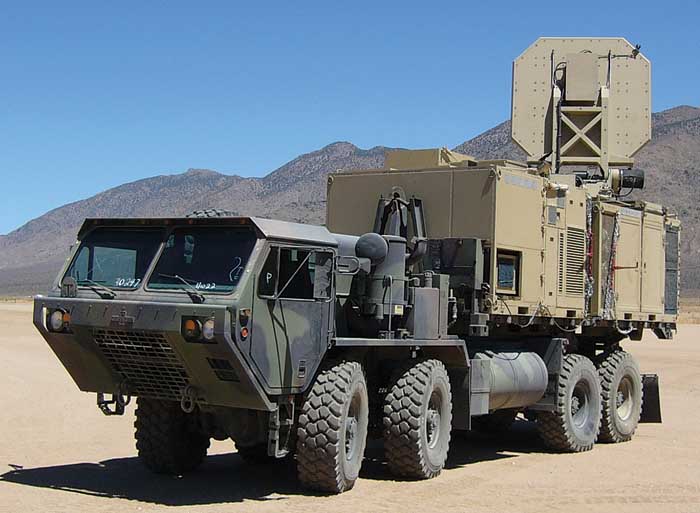
SAR: Applied Energetics recently announced a $4.5 million contract with ARDEC for development and advancement of its proprietary Laser Guided Energy (LGE), “a transformational weapon technology by which a controllable high voltage electric charge can be precisely guided by a laser through the atmosphere to produce a range of controllable effects against a variety of potential military and security targets.” Comment on this being used to counter improvised explosive devices (IEDs) and any other applications.
AEAD: Applied Energetics has a lab demo scheduled for March 2009 developing DE technologies to defeat anti-material targets. AE has the patent on certain aspects of this technology and much of this work is classified.
SAR: ARDEC’s official web page linked at www.pica.army.mil lists an impressive range of “advanced technologies” said to be used in its DEW work. While most are self-explanatory, please comment on work with acoustics and nanotechnology.
AEAD: ARDEC works a wide range of advanced energy weapon systems across (its) many departments. (We) can only comment on the efforts of the Advanced Energy Armaments Division (which includes the Directed Energy Branch) to say that AEAD has no ongoing efforts in nanotechnology. In addition, any acoustic work performed by AEAD is on evaluating non-lethal Commercial Off-the-Shelf devices that are considered to be “hailing and warning devices” and are not considered as “weapons.” Examples include the Long Range Acoustic Device (LRAD), etc.
SAR: What is Mr. Lagasca’s prediction on the first fielding of a scalable non-lethal to lethal DE weapon that can be carried and used by one man?
Lagasca: “Hand held Non-Lethal Laser Dazzlers have already been fielded and are currently available. These systems are mainly used as a non-lethal means to ‘warn’ and/or get the attention of people. These lasers are not considered weapons. Weaponization of lasers for lethal applications into a ‘hand-held’ form factor are a long way away. Currently there are no laser technologies or programs that I am aware of that could be weaponized into hand held size within say 10 years. Breakthroughs in laser and power source technologies would be required to realize laser weapons in this class. It should also be noted that all lethal laser development programs are focused on counter materiel applications and not counter personnel (at least the ones that I am aware of). Any laser weapon designed for lethal and/or non-lethal counter personnel use would have to undergo considerable legal policy review to assure conformance with applicable international treaties such as prohibition on blinding weapons.”
Electric Ships
The United States Navy’s future surface warships are under development right now and they represent the nearly ideal mobile platforms for utilizing all types of directed energy weaponry. These massive, oceangoing, all-electric vessels will have plenty of room on board for complicated apparatus and vast reserves of energy from the latest generation high-yield nuclear power plants.
Office of Naval Research (ONR) has long been interested in the potential of directed energy weapons for shipboard defense at the speed of light and, among other initiatives, is well underway with perfecting the “high average power infrared free electron laser.” FEL for short, it provides particularly intense beams that can be tuned to atmosphere-penetrating wavelengths. This tuning is an essential capability in conditions of thick fog, heavy rain and snow, making FEL weapons lethal in all weather against threat aircraft, watercraft, sea skimming missiles, and more.
And the practicality of including specialized kinetic energy weaponry on these future warships hasn’t been overlooked. Because there are times when slinging steel is the best solution to specific situations, the ONR is also hard at work on EMRGs (electromagnetic railguns). These exotic projectile pushers dispense with traditional chemical propellants or rocket motors in favor an electrically generated magnetic field that “levitates” a specialized metallic slug, launching it down track-like rails at previously unattainable speed.
Successful test firings have been conducted, with one demonstrating a mind-boggling muzzle velocity of 1.56 miles per second. With anticipated fielding some 15 years away, the Navy expects its EMRGs to fire 6 to 10 internally guided projectiles per minute with astonishing precision at ranges in excess of 200 nautical miles, about the distance from New York City to Boston.
KE/DE Combo
In retrospect, it was a bit unfair to ask the experts to predict fielding of an individual weapon using only directed energy to provide fully tunable effects from dazzle to death. Most respondents were quick to point out that a combination of a standard kinetic energy (KE) assault rifle, coupled with a “scalable effects” less-lethal directed energy (DE) device, is the most practical and logical interim step.
Indeed, when one takes into account such possible couplings as XADS’ Stun Strike Close Quarters Shock Rifle clamped to an M4 carbine, we’re getting there now.
More exotic hardware is in the works that promises to extend the reach of the DE module’s less lethal but incapacitating effects to eventually approximate the effective range of the decidedly lethal KE host weapon. The AEWS/Stellar Photonics’ “Synchronized Photo-pulse Detonation” may be one of these, said to employ two synchronized lasers that project an atmospheric shock wave of superheated plasma.
Lest one be tempted to dismiss this and similar efforts as quantum quackery, their development is being fueled by millions of defense dollars, awarded only after rigorous scientific review has validated their potential. Many firms have ongoing contracts and are working on classified counter-IED and other projects under supervision of various Department of Defense entities.
Because these will certainly get smaller, lighter and more powerful in the near future, your individual-issue ray gun seems inevitable. Thus, if Doctor Andrews’ startlingly bold prediction proves right, the first of USSOCOM’s elite warriors will be combat testing their one-man-portable “non-lethal weapons with a tunable destructive potential” in about three years.
The E-Bomb
“After more than two decades of research, the United States is on the verge of deploying a new generation of weapons that discharge light-wave energy, the same spectrum of energy found in your microwave, or in your TV remote control. They’re called ‘directed-energy weapons’ – lasers, high-powered microwaves, and particle beams – and they signal a revolution in weaponry, perhaps more profound than the atomic bomb.” (E-Bomb book jacket notes)
Published in 2005, this fascinating book carries the bold subtitle, “How America’s new directed energy weapons will change the way future wars are fought.” It has served quite well as our primary reference source for this feature, detailing the scientific concepts and evolving hardware of DE. While including plenty of formulas and diagrams for the more scientific-minded readers, these are accompanied by simple explanations and straightforward presentations, making it easily understood by the rest of us.
Its author, a retired USAF Colonel with a Doctorate in Physics, has particular credibility as a result of more than thirty years of experience, from conducting basic research to directing applied-science programs and formulating national policy. J. Douglas Beason’s last active duty assignment was Deputy Director for Directed Energy at the Air Force Research Laboratory.
He is currently the Associate Laboratory Director for Threat Reduction at Los Alamos National Laboratory, responsible for programs that reduce the global threat of weapons of mass destruction.
Doctor Beason graciously responded to our request for a prediction on the first fielding of a scalable non-lethal to lethal DE weapon that can be carried and used by one man. It is presented here in its entirety:
“Small arms Directed Energy Weapons (DEW) will provide the warfighter with the best of all worlds – speed of light engagement, little (if any) collateral damage, near-infinite precision, the ability to induce “graduated” effects (dial-an-effect), and best of all, not be constrained by ballistics or windage. In the near future, as technology matures and DEWs become smaller and capable of being fielded by individuals, a revolution will occur as DEWs move from strategic to tactical applications.
“The first use of small arms DEWs has been in the form of non-lethal weapons, for example dazzlers. As power supplies shrink and sub-THz (teraHertz) sources become more efficient, hand-held active denial units the size of back packs will become available.
“Because of technology limitations, it will take much longer to field a small arms lethal laser capability; but until then, the tactics and doctrine of using DEWs on the battlefield – and most importantly, the evolution of a national DEW policy – will mature.”
Find Out More
The following internet links are listed in their order of presentation in this feature:
Report: Defense Science Board Task Force on Directed Energy Weapons www.acq.osd.mil/dsb/reports/2007-12-Directed_Energy_Report.pdf
Defense Advanced Research Projects Agency: www.darpa.mil
US Army Space and Missile Defense Command: www.smdc.army.mil
US Air Force Research Laboratory: www.afrl.af.mil
US Navy Office of Naval Research: www.onr.navy.mil
Department of Defense Joint Non-Lethal Weapons Directorate: https://www.jnlwp.com
US Army Armament Research, Development and Engineering Center: www.pica.army.mil
FBI Academy Advanced Weapons Subject Bibliography: http://fbilibrary.fbiacademy.edu/bibliographies/advancedweapons.htm
Book: The E-Bomb www.dougbeason.com
| This article first appeared in Small Arms Review V12N9 (June 2009) |










